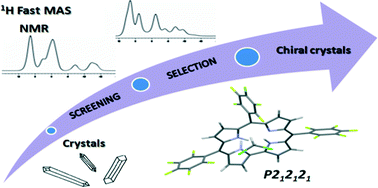Chiral crystals from porphyrinoids possessing a very low racemization barrier†
Abstract
The unique solid-state NMR technique Very Fast MAS with a sample spinning rate over 40 kHz was employed for screening and selection of crystals of porphyrinoid derivatives – corroles, suitable for X-ray diffraction studies. The host–guest approach and formation of inclusion complexes were efficient methods for the synthesis of chiral crystals from free base corroles possessing an extremely low racemization barrier. Our data show that the intrinsic features of corroles, including the dihedral angle saddling effect and distortion of the macrocyclic rings out of planarity, have no crucial influence on the tendency for symmetry breaking.


 Please wait while we load your content...
Please wait while we load your content...